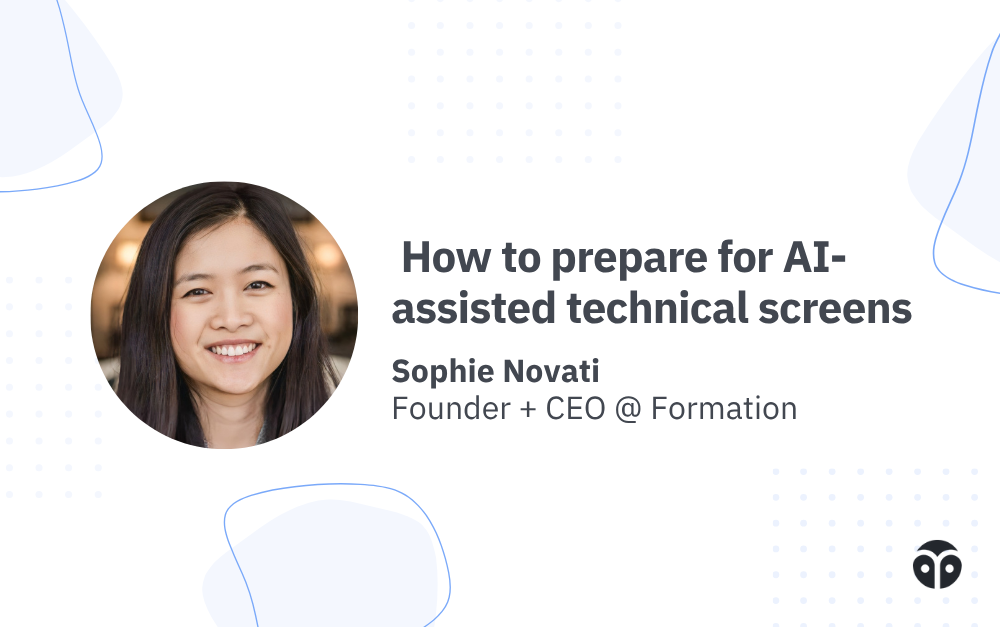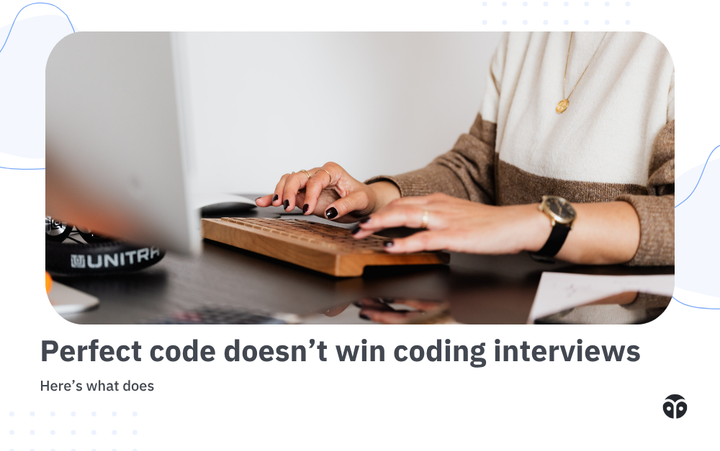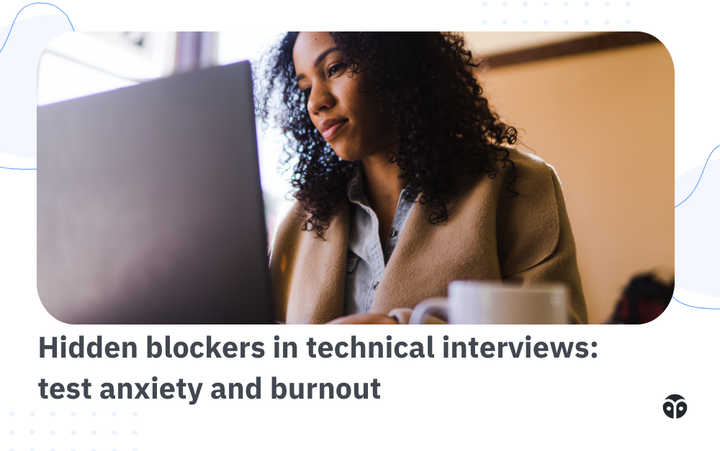The coding interview is changing: How to prepare for AI-assisted technical screens
Learn what’s changing, how interviewers now assess reasoning, collaboration, and verification, and how to prepare for the next wave of technical interviews where your ability to lead alongside AI is the real test.

LeetCode grinding isn’t cutting it anymore.
The interview landscape is splitting in two. Some companies (looking at you, Google 😁) might double down on “no-AI” interviews, the coding equivalent of a no-calculator math test. Others (like Meta) are going the opposite direction, baking AI directly into their interview process to see how well you collaborate with intelligent tools.
Both paths are valid, but the second one is spreading fast. AI-assisted coding interviews are already being conducted at progressive tech companies. As the big players start adopting them, others are following quickly.
If you haven’t faced one yet, now’s the time to get ready. The new bar isn’t just can you solve the problem? It’s can you lead the problem-solving when AI is part of the team?
Here’s what’s changing, how you’ll be evaluated, and how to prep effectively.
What's actually shifting? (the new interview format)
AI-assisted coding interviews look similar to traditional technical screens, but with one key addition: you have access to an AI coding assistant throughout the interview.
Like this screenshot, you'll typically have a coding panel on the left, an output panel, and a new AI chat panel where you can request help or ask it to generate code. The AI has context of your code and can generate implementations based on your instructions.
The models you will have access to are not typically flagship reasoning models (such as ChatGPT 5.0 or Sonnet 4.5 at time of writing, Oct 2025). These are typically less sophisticated models (like ChatGPT 4o-mini). Think of them as intelligent code completion tools that can generate functions, write test cases, or debug simple errors when prompted clearly.
Right now, many candidates are still getting through these interviews by ignoring the AI completely. That can work for now, but as the AI accelerates implementation, interviewers are starting to raise the bar in terms of performance and raising the ante with more complex problems with much richer starter code environment.So let’s take a look at the new signals that interviewers are looking for in this new format...
How will you be evaluated differently?
Interviewers are rethinking what “strong performance” looks like. In AI-assisted coding interviews, evaluation is shifting across five key dimensions:
01. AI context framing: How YOU explore the problem before the model does
Skipping problem exploration and clarifying questions was a classic mistake even before AI interviews, and now it’s even more important. With more starter code to explore and AI in the loop, your job in the first few minutes is to make sure you truly understand the problem space.
Strong candidates scan the starter code to identify key entry points, data structures, and contracts. What’s already implemented? What’s missing?They also restate the task in their own words, confirm inputs and outputs, and probe the edges of the problem: “What happens if two intervals overlap?” As you clarify, jot down each rule or exception you uncover. Every answer should tighten your plan or turn into a quick test case.
02. AI-Aware Reasoning: How you weigh tradeoffs and lead decisions
With AI handling syntax, your real edge is how you reason and decide. Great candidates don’t just describe what they’re doing. They compare options, weigh tradeoffs, and make clear judgment calls on which path to take. Interviewers are scoring your reasoning process, not just the end result.
Poor problem understanding or fuzzy communication is a red flag, even if the code eventually works by coincidence. The best candidates start by clearly articulating their understanding of the problem before writing a line of code, because that clarity is what allows them to guide the AI reliably toward the right solution.
03. AI collaboration fluency: How you translate strategy into action
Once you’ve chosen an approach, interviewers want to see how well you break it down and decide what stays human versus what to delegate to AI. Strong candidates keep ownership of the reasoning-heavy work by choosing data structures, handling edge cases, verifying correctness.
Delegate bounded, mechanical tasks like generating helper functions, writing boilerplate, or scaffolding tests. The skill isn’t in letting AI take over; it’s in knowing what to offload and when. This judgment is one of the skills interviewers now look for as the mark of AI fluency.
04. Communication clarity: How you translate thinking into instructions
Once you’ve identified the tasks you want the AI to handle, communication becomes the make-or-break skill.
In traditional interviews, strong code could sometimes offset weak verbal communication. You could show understanding through implementation. In AI-assisted interviews, that safety net disappears. Clear, structured communication isn’t just what your interviewer is evaluating. It’s now essential to getting to a working solution. Strong candidates describe intent before acting, using precise, instruction-style language that guides both the interviewer and the model: “Iterate through each interval, merging overlaps before adding to results.” When your communication is crisp, the AI amplifies your reasoning; when it’s vague, it magnifies confusion.
05. AI verification discipline: How you validate what the model builds
Because AI can generate plausible-looking but incorrect code, interviewers heavily weight your ability to validate outputs. Strong candidates generate comprehensive test cases (often with AI's help) and methodically verify edge cases.
They catch subtle bugs (ex: incorrect handling of overlapping string matches or missing case-insensitivity requirements) that AI implementations commonly miss. Weak candidates paste AI-generated code, see it pass basic tests, and declare victory without deeper verification.
How should you adapt Your interview prep?
This is where preparation gets specific. The following strategies will transform how you practice and naturally reveal why developing these skills requires more than solo grinding.
Master problem exploration before code exploration
The biggest failure mode in AI-assisted interviews is jumping to prompts or code before truly understanding the problem. You can start practicing this immediately. Force yourself to spend the first 5–10 minutes asking clarifying questions, reviewing any starter code, and outlining edge cases.
Ask questions that shape the algorithm: “What happens if two intervals overlap?” Start with the questions that will define your entire approach. Take notes as you go! This keeps you aligned with the interviewer and doubles as copy and paste-able gold for your AI prompts.
While a lot of this is timeless engineering advice, AI raises the stakes. The model can only reason with the context you provide. So, if you skip exploration, it can confidently build the wrong thing, and it’s often harder to catch because you weren’t involved in every coding step. Clear framing upfront is your best defense.
Practice this step with a friend or mentor acting as the interviewer. It’s great practice for gathering missing context that wouldn’t appear in a written prompt, exactly the kind of skill real interviews now test.
Develop your pseudo-code communication Style
Start translating algorithms into clear, instruction-style descriptions. Instead of thinking "I need a nested loop here," practice articulating: "Scan the text from left to right, checking in a case-insensitive way for the longest match at each index.
"You can practice this solo by solving problems without coding. Write step-by-step descriptions of your algorithm, then use AI to implement from your description. When AI produces incorrect code, your instructions were too vague.
Effective practice means: your descriptions should be detailed enough that another engineer could implement them without questions, yet high-level enough that they're not pseudo-code line-by-line. Try practicing with a friend and ask for feedback on whether you’re over-explaining (essentially writing code in sentences) or under-explaining (leaving critical details ambiguous).
Practice strategic problem decomposition
Work on breaking problems into right-sized chunks for AI collaboration. Too large, and the AI fails. Too small, and you’re not really leveraging it. The goal is to create instruction-style steps you could hand directly to the AI as prompts.
Try this: take a complex problem (like implementing string matching with a trie) and list 3–5 steps you’d delegate. Each should be big enough to save time but focused enough to explain clearly. For example: create node structure, build trie, search function. But should you split the search further? That depends on the problem’s complexity and the AI’s capabilities.
Finding the right granularity takes practice. To sharpen this skill, try solving problems in a language you’re less familiar with. It will force you to think and communicate with more clarity through the AI. The more clear your breakdowns, the more precise your AI execution will be.
Build strong code verification habits
In AI-assisted interviews, your ability to efficiently verify rapidly generated AI code is critical. Before you write a line of code, generate comprehensive test cases. Aim for 5–8 that cover the happy path, edge cases, and the tricky requirements you clarified earlier.
AI is useful for rapidly producing all kinds inputs – happy cases, as well as inputs that expose tricky bugs you can describe but might struggle to reproduce. Prompt it with “Generate test cases for this function covering no matches, case insensitivity, overlapping patterns, multiple separate matches.”, etc. But don’t just trust its output. Verify that each generated case is actually correct.
When practicing, try running the tests first. Then, if you find bugs when you later inspect the implementation, pause and analyze why: was the bug a missed edge case, a misunderstanding in the prompt, or a pattern you’ve seen before? Over time, you’ll get sharper at designing test suites that expose subtle logic errors.
Simulate interview pressure with AI tools and peers
Practice with actual AI coding assistants in timed conditions. Use tools like Cursor, GitHub Copilot, or Claude with artifacts in a constrained environment. Give yourself 45 minutes, solve problems while talking through your reasoning out loud, and use AI only through deliberate prompts.
Record yourself or practice with a peer. The goal is experiencing the cognitive load of: explaining your thinking verbally + prompting AI clearly + verifying generated code + managing time pressure.
What's genuinely challenging: in actual interviews, you're being evaluated on all these dimensions simultaneously. Practicing alone, you can't replicate the pressure of an interviewer watching your every move. Many engineers discover in actual interviews that their internal reasoning doesn't translate well to verbal explanation, but by then it's too late. Simulated interview conditions with someone providing feedback help you discover these gaps before they matter.
Study modern algorithm patterns that are now testable
With AI handling much of the implementation complexity, interviewers can now explore more sophisticated algorithmic concepts than traditional 45-minute formats used to allow. Problems that once felt too time-intensive to code by hand are becoming fair game again.
We are still seeing the fundamentals dominate – arrays and matrices, binary trees, recursion and backtracking, two-pointer techniques etc. are still the backbone of most interviews. But as engineers get faster with AI’s help, some interviewers are starting to mix in more advanced patterns like tries for string matching, segment trees for range queries, and graph algorithms involving complex state management.
Study the concepts and know when to apply them, but don't memorize implementations. Focus on understanding trade-offs and being able to articulate: "This problem calls for a trie because we're doing prefix matching on multiple patterns, which gives us O(m) lookup instead of O(n*m).
In AI-assisted interviews, conceptual mastery and communication matter more than syntax. The best candidates show they can recognize patterns, choose the right abstraction, and guide the AI for implementation.
The bottom line
The engineering method for solving problems hasn't changed—clarify the problem, explore solutions, commit to an approach, implement, and verify. But AI shifts where you spend your energy within that framework.
Success in AI-assisted interviews requires: exceptional problem decomposition skills, clear pseudo-code-style communication, strategic judgment about tool usage, and rigorous verification habits. These are learnable skills, but they're also subtle skills that benefit enormously from expert feedback and iterative practice.
You can start preparing today by slowing down your problem exploration phase, practicing instruction-style communication with AI tools, and building strong verification habits. The fundamentals are timeless. The application is evolving.
The window to adapt is now—before these formats become the industry standard and the competition intensifies. Start practicing deliberately, seek feedback on your approach, and focus on developing the strategic thinking skills that will matter in this new interview landscape.
Stay on top of changing industry trends and accelerate your career.



